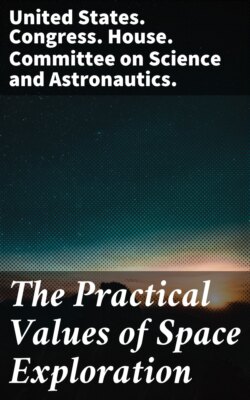Читать книгу The Practical Values of Space Exploration - United States. Congress. House. Committee on Science and Astronautics. - Страница 6
На сайте Литреса книга снята с продажи.
SOME EXAMPLES OF THE UNEXPECTED
ОглавлениеTable of Contents
A graphic illustration of "unseen" benefits in regard to atomic energy has been expressed by an experienced researcher in this way:
I remember a conversation I had with one of our nuclear scientists when I was a member of the Weapons Systems Evaluations Group almost 10 years ago. We were talking about the possible peaceful applications of fission. We really could think of little that could be done with it other than making fissionable material into a form of destructive power. There had been some discussion about harnessing the power of fission, but this seemed to us to be quite remote. It seemed difficult to conceive of the atomic bomb as anything but sheer power used for destructive purposes. Yet today the products of fission applied to peaceful uses are many. The use of isotopes in industry, medicine, agriculture are well known. Food irradiation, nuclear power reactors, now reactors for shipboard use, are with us, and it is hardly the beginning. I frequently ask myself, of late, what 10 years from now will be the commercial, shall we call it, applications of our missile and rocket programs.[2]
There are innumerable examples of the way in which invention or discovery, or sometimes just simple human curiosity, result in useful payoff. And frequently no one suspects the direction the payoff finally takes. The point, of course, is that any knowledge eventually pays dividends. The things we learn from our national space program will produce benefits in ways entirely unrelated to missiles or interplanetary travel. (See secs. III and IV.) The reverse is also true; knowledge gained in areas quite remote from outer space can have genuine value for the advance of space exploration.
Investigation into the skin of a fish provides a good case in point.
A German inventor who migrated to California after World War II had long been interested in ways to reduce the drag of friction produced by air or water on the surface of objects passing through them. One day, while watching a group of porpoises cavort past a speeding ship with the greatest of ease, it occurred to him that the skin of these animals, if closely studied, might shed light on ways of cutting surface friction. It was many years before the inventor was able to enlist the aid of aquarium managers in securing porpoise skins for study. In 1955, however, he obtained the necessary skins and found that dolphins, in fact, owe much of their great speed to a unique skin which markedly reduces the effect of turbulence against it. From this knowledge has come the recent development of a diaphragm-damping fluid surface which has real potential not only for underwater high-speed bodies, such as submarines, torpedoes and underwater missiles, but for any vehicle where fast-moving gases or fluids may cause drag.[3]
The implications of this knowledge for satellites near Earth or for reentering spacecraft are obvious.
Sometimes a reverse twist in reasoning by a speculative mind will result in enormous practical utility.
In Cambridge, Mass., a sanitary engineer teaching at the Massachusetts Institute of Technology began to wonder about the principles of adhesion—why things stick to each other. Do they only stick together because some sticky substance is holding them, or are there other reasons? "If a person is sick," he asked himself, "is it because a cause of sickness is present or because a cause of health is absent? We now know that in infectious diseases the first alternative is true; the patient is ill because he harbors pathogenic germs. The opposite case prevails in deficiency diseases, where necessary vitamins are absent from food and illness is brought about by this absence. To which of the classes does adhesion belong? When we cannot produce a dependable bond, are we dealing with the lack of some adhesive force or with existence of an obstacle to sticking?"
Operating on the theory that adhesion might result not only from the presence of a sticky agent but from the removal of all impediments to sticking, this scientist has now managed to produce strong adhesion between the least sticky of substances—polyethylene plastics. He has done it by studying the molecular structure of polyethylenes and removing all impurities which normally find their way into the manufacture of such material. The next step: "We hope to prepare adhesive joints in which a noble gas acts as an adhesive. Noble gases are the least active substances known to chemistry; if they can adhere, it is clear that no specific forces are needed for adhesiveness."[4]
No great imagination is required to perceive the meaning which this new knowledge, if proved out, will have for our everyday lives—to say nothing of its usefulness in the making of astronautic equipment.
